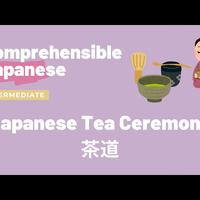Japanese Tea Ceremony 茶道 - Intermediate Japanese 日本 語 中級
japanese|tea|ceremony|さどう|intermediate|japanese|にっぽん|ご|ちゅうきゅう
Japanische Teezeremonie - Japanisch für Fortgeschrittene
Japanese Tea Ceremony - Intermediate Japanese
Ceremonia japonesa del té - Japonés intermedio
Cerimónia do Chá Japonês - Japonês Intermédio
日本茶道 - 中级日语
日本茶道 - 中級日語
今日 の テーマ は 茶道 です
きょう||てーま||さどう|
日本 に 昔 から 伝わる 伝統 文化 、茶道 に ついて 話します お茶 の 道 と 書いて 茶道 と 読みます
にっぽん||むかし||つたわる|でんとう|ぶんか|さどう|||はなし ます|おちゃ||どう||かいて|さどう||よみ ます
I'm going to talk about a traditional Japanese culture, the tea ceremony.
茶道 と は 簡単に 一言 で 言う と 「お茶 を 飲む こと 」です が 単に お茶 を 飲む だけ では ありません
さどう|||かんたんに|いちげん||いう||おちゃ||のむ||||たんに|おちゃ||のむ|||あり ませ ん
The tea ceremony is simply one word for "drinking tea," but it is more than just drinking tea.
まず 簡単に 茶道 の 歴史 を 紹介 したい と 思います お茶 は 元々 中国 が 原産 地 です
|かんたんに|さどう||れきし||しょうかい|し たい||おもい ます|おちゃ||もともと|ちゅうごく||げんさん|ち|
First of all, I would like to give you a brief history of the tea ceremony, which originally originated in China.
一 番 最初に お茶 が 作ら れた の は 中国 です 8世紀 から 9世紀 頃 、奈良 時代 から 平安 時代 の 頃 に 日本 に 伝わりました
ひと|ばん|さいしょに|おちゃ||つくら||||ちゅうごく||せいき||せいき|ころ|なら|じだい||へいあん|じだい||ころ||にっぽん||つたわり ました
その頃 「遣 唐 使 」と いわ れる 人 たち が いま した 遣 唐 使 たち は
そのころ|つか|とう|つか||||じん|||||つか|とう|つか||
At that time, there were people known as "Tang Dynasty envoys." These envoys were called "Tang Dynasty envoys.
日本 から 中国 に 行って 、中国 で 勉強 して 学んだ 知識 を 日本 に 持ち帰って いました
にっぽん||ちゅうごく||おこなって|ちゅうごく||べんきょう||まなんだ|ちしき||にっぽん||もちかえって|い ました
I went from Japan to China and brought back to Japan the knowledge I had learned from studying in China.
遣 唐 使 たち が 中国 から 日本 に 帰国 する 際 に お茶 の 種 を 持ち帰った そうです
つか|とう|つか|||ちゅうごく||にっぽん||きこく||さい||おちゃ||しゅ||もちかえった|そう です
When the Tang Dynasty envoys returned to Japan from China, they brought back tea seeds.
そして 日本 でも お茶 が 栽培 さ れる ように なりました でも この 時 は 実は あまり 日本 に お茶 は 広まりません でした
|にっぽん||おちゃ||さいばい||||なり ました|||じ||じつは||にっぽん||おちゃ||ひろまり ませ ん|
And so tea began to be grown in Japan, but at this time it was not really spreading in Japan.
それ から しばらく 経って 12世紀 、鎌倉 時代 に 今度 は 栄 西 いう 名前 の 仏教 の お 坊さん が 中国 に 留学 しました
|||たって|せいき|かまくら|じだい||こんど||さかい|にし||なまえ||ぶっきょう|||ぼうさん||ちゅうごく||りゅうがく|し ました
Some time later, in the Kamakura period (12th century), a Buddhist monk by the name of Eisai studied in China.
そして 彼 も また 帰国 する 時 に お茶 の 種 を 持ち帰りました
|かれ|||きこく||じ||おちゃ||しゅ||もちかえり ました
そして 日本 に 帰国 後 お茶 の 飲み 方 や お茶 の 栽培 方法 など を まとめた お茶 の 専門 書 を 書きました
|にっぽん||きこく|あと|おちゃ||のみ|かた||おちゃ||さいばい|ほうほう||||おちゃ||せんもん|しょ||かき ました
After returning to Japan, he wrote a book on tea, which included information on how to drink tea and how to cultivate tea.
その 当時 お茶 は 薬 と して 飲まれて いた そうです
|とうじ|おちゃ||くすり|||のま れて||そう です
Tea was used as a medicine in those days.
その後 徐々に 仏教 の お 坊さん の 間 で 広まりました 武士 の 間 でも 流行 して 薬 と して だけ で は なく
そのご|じょじょに|ぶっきょう|||ぼうさん||あいだ||ひろまり ました|ぶし||あいだ||りゅうこう||くすり||||||
Gradually, it became popular among Buddhist priests, and even among warriors, not only as a medicine, but also as a means to "save the people of the land.
飲み物 と して も 楽しま れる ように なりました パーティー の ような お 茶会 を 開いて みんな で お茶 を 飲んで 楽しむ ように なりました
のみもの||||たのしま|||なり ました|ぱーてぃー||||ちゃかい||あいて|||おちゃ||のんで|たのしむ||なり ました
It became a drink that people enjoyed as well, like a party, like a tea party, where everyone could enjoy drinking tea together.
そこ に 村田 珠光 と いう 名前 の 仏教 の お 坊さん が 「禅 」の 考え 方 を 取り入れて 現在 の 茶道 の 基 と なる
||むらた|しゅひかり|||なまえ||ぶっきょう|||ぼうさん||ぜん||かんがえ|かた||とりいれて|げんざい||さどう||もと||
A Buddhist priest by the name of Murata Shukoh introduced the ideas of Zen into the tea ceremony, which is the basis of the tea ceremony today.
「侘び 茶 」と いう もの を 始めました その後 千 利 休 と いう 人 が それ を 更に 発展 さ せて 今 の 茶道 が 出来ました
わび|ちゃ|||||はじめ ました|そのご|せん|り|きゅう|||じん||||さらに|はってん|||いま||さどう||でき ました
Later, Sen no Rikyu developed it further, and the tea ceremony as we know it today was born.
お茶 に も 色々な 種類 が ある んです が 茶道 で 飲む お茶 は 抹茶 です
おちゃ|||いろいろな|しゅるい|||||さどう||のむ|おちゃ||まっちゃ|
濃い 緑色 の お茶 です 抹茶 の 粉 と お 湯 を 茶碗 に 入れて
こい|みどりいろ||おちゃ||まっちゃ||こな|||ゆ||ちゃわん||いれて
この 茶 筅 と いう 道具 を 使って かき混ぜて お茶 を 作ります 茶道 の 言葉 で は お茶 を "点 てる "と 言います
|ちゃ|せん|||どうぐ||つかって|かきまぜて|おちゃ||つくり ます|さどう||ことば|||おちゃ||てん|||いい ます
The tea is made by stirring the tea using the chasen, or tea whisk, which in the language of the tea ceremony is called "making the tea."
茶道 で は 、立ち 方 から 歩き 方 座り 方 茶碗 の 持ち 方 混ぜ 方 道具 を 置く 場所
さどう|||たち|かた||あるき|かた|すわり|かた|ちゃわん||もち|かた|まぜ|かた|どうぐ||おく|ばしょ
In the tea ceremony, from how to stand, how to walk, how to sit, how to hold the bowl, how to mix the tea, where to put the utensils, and so on.
ふきん の たたみ 方 お茶 の 飲み 方 お辞儀 の 仕方
|||かた|おちゃ||のみ|かた|おじぎ||しかた
How to fold a dish towel How to drink tea How to bow
お 菓子 の 食べ 方 まで 一つ一つ 細かく ルール が 決まって います
|かし||たべ|かた||ひとつひとつ|こまかく|るーる||きまって|い ます
There are detailed rules on how to eat the snacks.
この 決まり の こと を 「作法 」と 言います 作法 に 従って お茶 を 飲みます
|きまり||||さほう||いい ます|さほう||したがって|おちゃ||のみ ます
This rule is called "sakuho," or the way we drink tea.
そして 茶道 と いう の は ただ お茶 を 飲む だけ では ありません
|さどう||||||おちゃ||のむ|||あり ませ ん
And the tea ceremony is not just about drinking tea.
お茶 を 飲む 部屋 の こと を 「茶室 」と いいます が この 茶室 の 空間 や 茶室 から 見える 庭 の 景色
おちゃ||のむ|へや||||ちゃしつ||いい ます|||ちゃしつ||くうかん||ちゃしつ||みえる|にわ||けしき
The room where tea is served is called a "tearoom," and the space in the tearoom and the view of the garden from the tearoom are also called "chashitsu," meaning "tea room.
茶室 に 飾る 花 、使う 道具 や お茶 と 一緒に 出す お 菓子 など 全部 含めて 茶道 です
ちゃしつ||かざる|か|つかう|どうぐ||おちゃ||いっしょに|だす||かし||ぜんぶ|ふくめて|さどう|
The tea ceremony includes everything from the flowers that decorate the tea room to the utensils used and the sweets served with the tea.
お 茶会 を 開く 人 は その 全て に 気 を 配って 全て を 考えて お 客 さん を お もてなし します
|ちゃかい||あく|じん|||すべて||き||くばって|すべて||かんがえて||きゃく|||||し ます
The person who throws a tea party is the one who takes care of everything, who thinks about everything, who entertains the guests.
「一期一会 」と いう 茶道 の 言葉 が あります これ は "一生 に 一 度 の 出来事 "と いう 意味 です
いちごいちえ|||さどう||ことば||あり ます|||いっしょう||ひと|たび||できごと|||いみ|
There is a term in the tea ceremony called "ichiki ichikai," which means "a once-in-a-lifetime event."
1回 1回 の お 茶会 を 人生 に 一 度 しか ない 時間 と 考えて 最高の おもて なし を しましょう
かい|かい|||ちゃかい||じんせい||ひと|たび|||じかん||かんがえて|さいこうの||||し ましょう
Think of each tea party as a time that comes but once in a lifetime, and make the best of it.
そして もてなす 人 も お 客 さん も お互いに 一生 に 一 度 しか ない この 時間 を 大切に しましょう と いう 意味 です
||じん|||きゃく|||おたがいに|いっしょう||ひと|たび||||じかん||たいせつに|し ましょう|||いみ|
It also means that both the host and the guest should cherish this time, which comes only once in a lifetime.
とても 素敵な 言葉 だ なぁ と 思います 私 は 昔 、小学生 の 頃 に 何 回 か
|すてきな|ことば||||おもい ます|わたくし||むかし|しょうがくせい||ころ||なん|かい|
I think it's a very nice word.
茶道 を やった こと が あります 私 の おば が 趣味 が 茶道 だった ので おば に 教えて もらって 2,3回 やった こと が あります
さどう|||||あり ます|わたくし||||しゅみ||さどう|||||おしえて||かい||||あり ます
I have done tea ceremony a couple of times because my aunt was into tea ceremony and she taught me.
その 時 は まだ 子供 だった しか なり 昔 の こと な ので もう 忘れて しまいました
|じ|||こども||||むかし||||||わすれて|しまい ました
I was only a child at the time, but it was so long ago that I had already forgotten about it.
いつか 機会 が あったら また やって みたい なぁ と 思います
|きかい||||||||おもい ます
今日 は 茶道 に ついて 話しました 今日 は これ で おしまい
きょう||さどう|||はなし ました|きょう||||
また ね!

